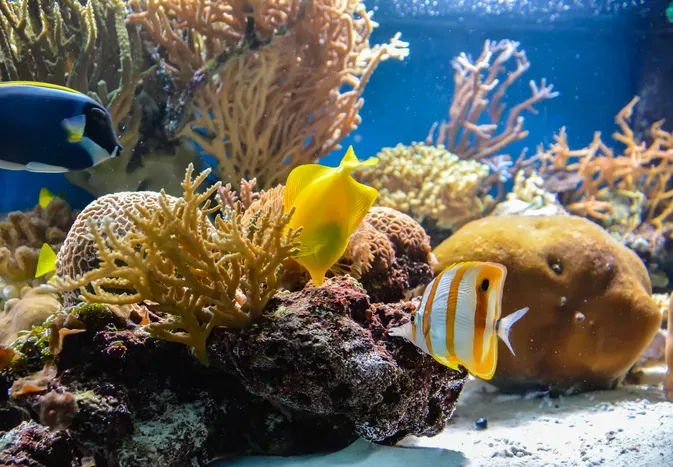How to Control and Prevent Algae in Your Fish Tank
Updated on 04/26/24

Conquer Algae Invasions: A Comprehensive Guide to Pristine Aquariums
Algae, the bane of aquarium owners, can quickly transform crystal-clear waters into murky battlefields. But fear not, fellow aquarists, for we embark on a literary crusade to empower you with the knowledge and strategies to control and prevent these photosynthetic foes.
Understanding the Algae Enigma
Algae, in its myriad forms, is a ubiquitous presence in aquatic ecosystems. These single-celled organisms thrive in nutrient-rich environments and can rapidly multiply under favorable conditions. In aquariums, excessive algae growth can diminish water clarity, interfere with photosynthesis, and adversely affect fish health.
Types of Algae: Know Your Foe
* Green Algae: The most common type, green algae forms slimy coatings on tank surfaces and obstructs plant growth. It thrives in bright light and high nutrient levels.
* Brown Algae (Diatoms): Diatoms are unicellular algae that appear as a brownish film on tank surfaces. They prefer cool temperatures and ample silica.
* Red Algae (Rhodophyta): Red algae often grows in dense, brush-like formations. It can be challenging to control and thrives in high nutrient and low light conditions.
* Cyanobacteria (Blue-Green Algae): Cyanobacteria, despite its name, isn't a true algae. It forms blue-green mats or scum and can produce toxins harmful to fish.
Causes of Algae Proliferation: Unmasking the Culprits
* Excess Nutrients: Overfeeding, decaying organic matter, and inadequate filtration contribute to high nutrient levels, fueling algae growth.
* Inadequate Lighting: Insufficient lighting can stunt plant growth, allowing algae to outcompete them for nutrients and space.
* Poor Filtration: Inefficient filtration fails to remove nutrients and organic waste, creating an algae-friendly environment.
* Water Chemistry Imbalances: pH, hardness, and alkalinity fluctuations can stress plants and promote algae growth.
* New Tank Syndrome: In newly established tanks, the biological filter is immature, leading to nutrient imbalances and algae proliferation.
Prevention: A Proactive Approach to Algae Control
* Balanced Feeding: Avoid overfeeding and remove uneaten food promptly.
* Regular Maintenance: Perform regular water changes to remove excess nutrients and organic waste.
* Adequate Filtration: Invest in a powerful filter with a capacity appropriate for your tank size and bioload.
* Optimal Lighting: Provide bright, indirect lighting for 8-12 hours daily.
* Healthy Plants: Vigorous plants outcompete algae for nutrients and reduce light availability.
Eradication: Reclaiming Your Aquarium Oasis
* Manual Removal: Use a scraper, brush, or vacuum to physically remove algae from tank surfaces.
* Chemical Treatments: Algicides and algaecides can effectively target specific types of algae, but use with caution.
* Biological Control: Introducing algae-eating species, such as snails, shrimp, or fish, can help control algae growth.
* UV Sterilization: UV sterilizers emit ultraviolet light that can kill algae spores and prevent their proliferation.
Case Studies: Triumphs Over Algae
Example 1: In a heavily planted 55-gallon aquarium, a sudden algae bloom was traced to overfeeding and inadequate filtration. By reducing feeding frequency, installing a more powerful filter, and implementing regular water changes, the algae growth was drastically reduced.
Example 2: A 20-gallon aquarium plagued by brown algae (diatoms) benefited from increased lighting duration and weekly water changes. The diatoms gradually subsided, allowing plants to flourish and provide natural algae control.
Example 3: To combat a persistent red algae infestation, an algae scraper was used to remove visible algae, followed by the introduction of algae-eating snails. With consistent maintenance and nutrient management, the red algae was successfully controlled.
Conclusion: Maintaining Algae-Free Harmony
Controlling and preventing algae in aquariums requires a comprehensive approach that addresses the underlying causes. By implementing preventive measures, monitoring water quality, and employing effective eradication techniques, you can establish a thriving underwater ecosystem where algae are kept in check and your fish can flourish. Remember, a pristine aquarium is not only aesthetically pleasing but also vital for the well-being of its inhabitants. Embrace these strategies and enjoy the tranquility of a crystal-clear aquatic wonderland.
Explore More Pets

Freshwater Aquarium Filters
How to Deal With Cloudy Aquarium Water

Saltwater Aquarium Filters
How Do You Remove Chloramines From Tap Water?

Freshwater Aquariums & Habitat
Can I Keep My Koi Fish Inside?

Saltwater Aquariums & Habitat
14 Best Floating Plants for Your Aquarium

Freshwater Fish Health
How to Treat Ich on Freshwater Fish

Saltwater Fish Health
Fin Rot in Aquarium Fish

Freshwater Aquarium Filters
How to Do Aquarium Water Changes

Saltwater Fish Health
How Do Fish Get Parasites?